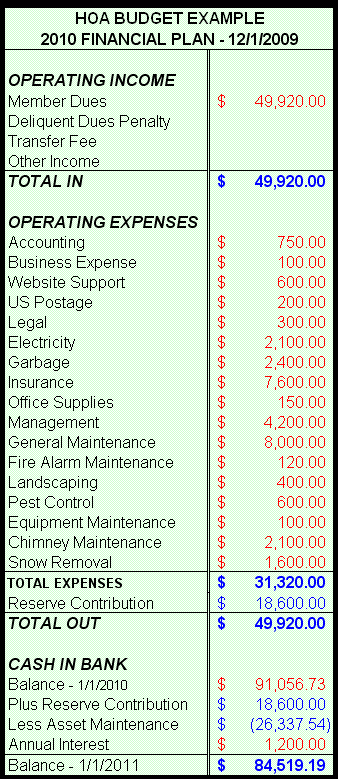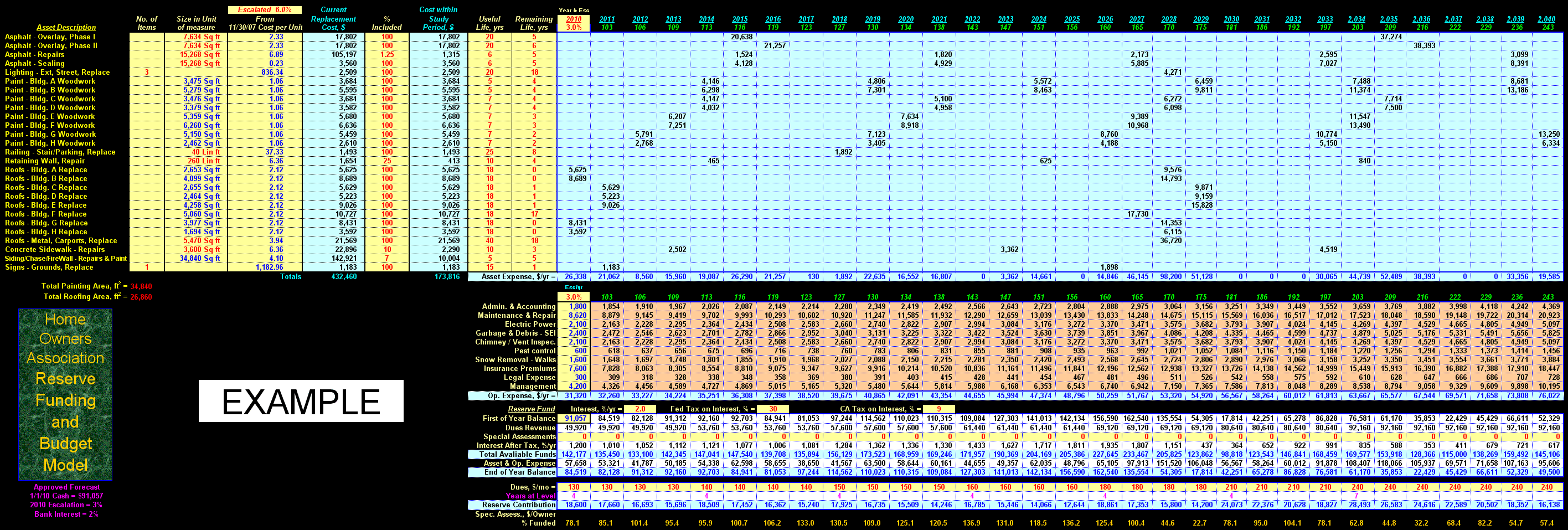 Those Home Owners
Associations that have common areas and facilities have two
types of financial management to deal with. The first is annual
operating expense. For example, utilities, management fees,
insurance, and supplies would be in this first category. But
the second is replacement of depreciating common assets. These
consist of things like private roads, buildings, recreational
facilities, and fences, etc. Those Home Owners
Associations that have common areas and facilities have two
types of financial management to deal with. The first is annual
operating expense. For example, utilities, management fees,
insurance, and supplies would be in this first category. But
the second is replacement of depreciating common assets. These
consist of things like private roads, buildings, recreational
facilities, and fences, etc.
The Budget is pretty
straight forward. An HOA Board would develop a "zero
based" budget each year which is just a compilation of expected
operating expenses and bills. However the forecast of required
revenue for Replacement or Major Repair of Common Facilities is more
difficult. Diligent completion of these two studies permits the
HOA Board to establish the required Regular Assessments (Dues) for the
membership.
There are many companies that analyze
HOA common facilities and prepare a "Reserve Study"
for a fee. These can be expensive and somewhat
confusing. HOA Boards are lead to believe that they must pay
for a service by a company that specializes in providing reserve studies
for community associations. For a Board to prepare this analysis
themselves, "due diligence" is certainly required.
But, a specialized company to do this is not necessary.
The purpose of this part of my website
is to give "screen shot" examples my system. An
HOA Board can construct this sensible financial management system, avoid
hiring a specialized company for a Reserve Study, and keep the HOA
members completely informed. It employs a clear, straight forward
budget, linked to an easy-to-understand "Reserve Funding and
Budget Model".
Here is an Example of a Simple
Budget. In this case the home owners association
consisting of 32 town houses. The regular assessments (monthly
dues) are $130. These are association Operating Expenses
that include a Reserve Contribution (leftover cash).
It also includes the association Cash Position (all liquid
assets). This considers the starting balance, the Reserve
Contribution, Asset Maintenance planned for the coming
year, in this case 2010. The philosophy is totally about current
cash available and forecasted cash flow, in this case for the next 30
years. Financial concepts are kept as simple and sensible as
possible. |
| Forecasting the maintenance
needed for the association's assets that eventually must be repaired or
replaced, conceptually is pretty simple. Look at the example
below. Let's consider the need to paint the woodwork for
building C and follow it through. First we need the to measure or
specify the surface area to be painted, "Size in Unit of
measure". Note that if size is not a factor, "No.
of Items" is. But in our case, 3,476 sq ft
(blue) has been calculated from another spreadsheet and transferred
here. It could have been entered directly (red).
The next column, "From 11/30/07 Cost per Unit"
figure, $1.06/sq ft, has been escalated by 6.0%/yr to update the
current unit price of an older quotation. Then, the "Current
Replacement Cost", $3,684, is calculated in the next
column. If we're considering that the whole defined area needs
painting each time we do it, the "% Included"
will be 100%. If only a fraction of the area needed repainting,
then a lower percentage would be inserted. In this case, the
"Cost within Study Period" is the same at
$3,684.
Now, the "Useful Life"
must be projected into the future. This can be obtained by paint
manufacturers or painting contractors. For all other elements in
the scope, a useful life estimate must be obtained. In this case
we have estimated 7 years. Depending on when the building was
painted, it's easy to estimate the "Remaining Life"
and for this year, 2010, it is 4 years. The year of 2013, will be
the last year of the paint's life and must be repainted in 2014.
The spreadsheet formulas handle this for all scope elements
automatically, so there is no tedious computations to be made. All
you have to do is to adjust the inputs and the spreadsheet handles it in
split seconds. So it very easy for Board of Director members to
experiment with that forecast until a realistic annual cost of asset
maintenance can be predicted. Of course this is only an
estimate. Each year prior to the development of the Association
Budget, this forecast should be updated.
This is much more convenient that
receiving an "hard copy report" from a professional
organization for which, 1) you have a lot of newly defined terms to
understand, and 2) you have to depend on contacting the company for
adjustments, usually at a price. This way, you have the model at
your finger tips for easy revisions, updates and
corrections.. In concert with, or as a member of the Board, you can come up
with a
reasonable financial plan that is explainable to the membership.
And that's very important!! So you are in control. |
 Those Home Owners
Associations that have common areas and facilities have two
types of financial management to deal with. The first is annual
operating expense. For example, utilities, management fees,
insurance, and supplies would be in this first category. But
the second is replacement of depreciating common assets. These
consist of things like private roads, buildings, recreational
facilities, and fences, etc.
Those Home Owners
Associations that have common areas and facilities have two
types of financial management to deal with. The first is annual
operating expense. For example, utilities, management fees,
insurance, and supplies would be in this first category. But
the second is replacement of depreciating common assets. These
consist of things like private roads, buildings, recreational
facilities, and fences, etc.

